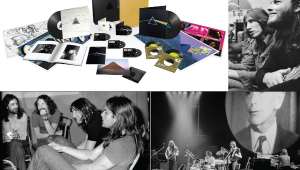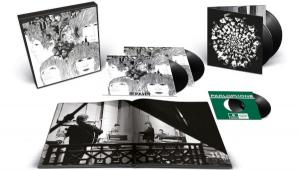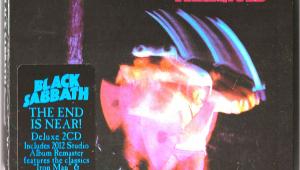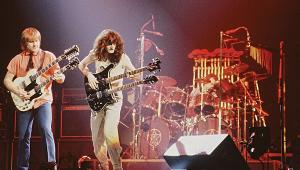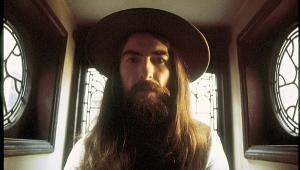The Atmos Branch Page 2
That said, "whatever sounds good" is certainly a huge understatement when it comes to the abject power inherent in the Atmos mix of C/C's opening 8-minute opus, "Harridan," which features dramatic volume swells, hard-hitting proto-metal sequences, strategic falsetto, and a free-form, slow-burn noodling section. In essence, "Harridan" encapsulates the full promise of what Porcupine Tree fans have come to expect over the years — and beyond. "What you hear in that song particularly is something probably true of almost everything I've done," Wilson assesses. "I don't think I've ever made a record you can just throw on in the background and not engage with it. Obviously, in careerist terms, that's been an Achilles heel because, how do you sell music like that in today's world — music that demands an awful lot from the listener? You're asking for engagement on a fairly deep level, and you're asking for them to give you their time to absorb it, listen multiple times, and decode all the various layers and things we're putting into the music. But I can't make music any other way. That's what I love to do — and that also spirals into why I love Atmos and 5.1 so much. It's another way to present all the complexity — not in terms of the music, but complexity in terms of the amount of layering and detail."
Speaking of added layers, this is where Barbieri's compositional expertise comes to C/C's fore, seeing as his mastery at adding keyboard swoops and swaths in all the right places is on full display. As Harrison puts it, "Richard specializes in sound design. He's not a 'come in and jam' guy — he's much more considered, and he adds a great deal of beauty to things." Adds Wilson, "I know Richard enjoyed making this record perhaps as much as any record we've ever made, because there was more space for him to speak and communicate what he does so well, with the guitars taking a slightly less-dominant role." Concludes Barbieri, "I think what I give to Steven to work with lends itself to this immersive sound palette of ours."

For his part, Harrison cites the core album's final track, the ultimately explosive "Chimera's Wreck," as the breakthrough that unlocked everything. "That's the real epic," he believes. "We made waves with the shifting tempos, to the point where the lyrics would just fall over these crests."
Wilson adds both "Harridan" and "Chimera's Wreck" were the bedrock tracks setting the table for everything that came thereafter. "They're both epic tracks, and they both were essentially written with me on bass, and Gavin on drums," he reports. "The exception would be the opening section of 'Chimera's Wreck,' which we wrote with me on acoustic guitar and Gavin on drums — but those tracks were both developed with us face to face in his studio, recording live."
"Chimera's Wreck" is also notable because of the human elements evident in the way it ebbs and flows. "It isn't even played to a click track; it's in free time," Wilson catalogs. "It speeds up, and it slows down. And that's an old-school way of recording — the two of us just facing each other, letting the track speed up and slow down as we feel it."
Within that special Wilson/Harrison push/pull were the keys to the entire C/C kingdom. "To echo what Gavin said, when we had those two tracks down, we knew we had something we could build on," Wilson observes. "We knew we had a way forward. The one thing I felt very strongly about is there would be absolutely no point for Porcupine Tree coming back with another record that just felt like more of the same." Considering the way the other five C/C cuts fill out the track listing — the deceptively gentle approach to "Of the New Day," the disapproving eye of "Rats Return," the Mellotron melodrama of "Dignity," the vengeful snarl of "Herd Culling," and the Barbieri showcase "Walk the Plank" — its release was never really in doubt.
Arriving Somewhere Beyond Here
Given how Atmos-centric Wilson's mixing proclivities are these days — as alluded to earlier, he told me off the record he's already completed (and will soon enough be doing more) Atmos mixes for a number of historical-oriented collections to come from top-shelf name artists, some of whom were respectively prominent in different decades — it would only seem logical Wilson apply his magic Atmos touch to other entries in the vaunted Porcupine Tree canon itself. Since PTree's September 2002 breakthrough In Absentia received a 3CD/1BD box set refresh in early 2021 with its 5.1 mix on Blu-ray, in turn making it something he wouldn't revisit right away, I felt March 2005's Deadwing would be the next best catalog choice to get "Atmos-ized." Wilson demurs ever-so-slightly about whether he's in the midst of doing Deadwing or not, but he does commit to a broader statement regarding the status of much of the work he's done in 5.1 throughout the years. "I will be revisiting not only my own records, but some other records I've mixed in 5.1 over the last 10 years that I'm now being asked to do in Atmos — and I am doing some of them," he clarifies. "It's great to have this whole new way to present these albums, yet again."

Even More / Even Less
The real unanswered questions, though, are these: Does Porcupine Tree have any further new music branches growing up their collective sleeves? Is something already in the air, since Closure is the word that comes first in the album title, and Continuation comes second? Is the door open to getting more as-yet-unheard PTree music to come, earmarked for additional glory in Atmos? "I hadn't really thought about it that way, to be honest," Wilson claims. "The order of the title is just the way it sounded—and it sounded right to me. This is closure, but it could also be continuation—and there's an implied question mark at the end of the title as well. The reality is, we don't know whether this is going to be the last record we make. If it is the last record we make under the name Porcupine Tree, it's a beautiful way to close the story—but it may not be. I think people think we're playing with them — and of course we are, with the title. We are playing with people's expectations a bit, but we genuinely, genuinely don't know."
The gist of that last answer brought to mind a key passage I read in Wilson's April 2022 autobiography, Limited Edition of One (Constable), wherein he freely admits to outright lying to journalists on many an occasion to suit the narrative. I ask Wilson, point blank, to identify how many times he's lied to me in all the years we've known each other. "Oh, I've never lied to you, Mike. You're the exception," Wilson replies, albeit accompanied with a slight Cheshire smile before adding the kicker, "But that could be a lie too."
Regardless of that semi-ambiguous final serve and volley, one thing we can all agree is not a lie is this: Porcupine Tree's Closure / Continuation is indeed a new gold standard for Atmos mixes, and it only portends greater things ahead — and above, and off to the sides, and all around us.

